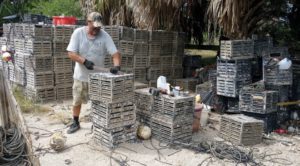Of the six shellfish species harvested in the Big Bend, several are harvested commercially. Blue crabs, stone crabs, shrimp and oysters have supported important fisheries in the area’s working waterfront communities for many years and still do so today. Only oysters can be commercially harvested with a Saltwater Products License, while blue crabs, stone crabs and shrimp require additional endorsements. Rules pertaining to commercial harvest of these shellfish include limits on size and bag (amount), closed seasons, regional and gear restrictions. For the most current regulations, visit Florida Fish and Wildlife Conservation Commission: https://myfwc.com/fishing/saltwater/commercial/.

Shrimp Fishery
The fishery began in the 1960s and boomed during the 1970s-90s with over a half million pounds of pink shrimp harvested annually by a fleet of 40 or so vessels in Yankeetown and Horseshoe Beach. The use of a roller frame trawl allowed for capture of shrimp in huge volumes along the rocky and grassy seafloor by towing nets rigged with rollers attached to the rigid frame openings. Pink shrimp are nocturnal, burrowing in the sediment during the day, so shrimping was done at night in nearshore to offshore waters. However, increasing competition from imports, fuel costs, and regulations led to a decline in landings of food shrimp. Today, high-value markets have revitalized the fishery. Live shrimp are now shipped to metropolitan areas for Asian consumption. The use of shrimp as bait for sports fishing has also grown and the bait fishery has become increasingly important. Juvenile pink shrimp are harvested from inshore waters and kept alive in aerated tanks.

Oyster Fishery
The oyster fishery is an integral part of Cedar Key’s history. Commercial operations began in the 1870s with much of the catch shipped out by railroad. Oyster reefs were decimated after the great storm of 1896 but recovered enough in the 1900s to support two canning factories employing 50 tongers. Although harvesting oysters has long been a favorite pastime in Dixie County, the commercial fishery began about 50 years ago. Oysters are harvested from natural reefs using long-handled tongs from small boats or by hand during “pick-up” (extremely low) tides. Recent landings have gone from a 2004 low of 54,598 lbs (attributed to hurricanes) to 221,417 lbs in 2016 with a dockside value of $1.1 million.

Blue Crab Fishery
Crabbing did not reach economic importance in the Big Bend until after World War II. Young men returning from the war began to exploit markets created by increasing demand for seafood. In the 1960s, blue crab production peaked following the introduction of the crab trap. Local processing plants, where the meat was cooked, picked and packaged, handled much of the catch. Imports now compete with crab meat products and landings have declined. However, the commercial fishery continues to be important in the Big Bend with most of the catch going to the live markets. The fishery relies on baited traps, made of plastic-coated, galvanized wire with funnel-shaped entries. Marked buoys identify the traps and their owners. Male crabs (called “jimmies”) are targeted because of their size and meat content, while harvesting of egg-bearing females is prohibited. Soft shell crabs are blue crabs that have shed their hard shell to grow or mate. Crabs that are ready to molt (called “peelers”) are held in shore-based tanks and harvested immediately after molting before the new shell can harden. They can be eaten whole and are a delicacy.

Stone Crab Fishery
Floridians have been fishing for stone crabs since the early 1800s. Stone crabs have been harvested commercially in the Big Bend since at least the 1920s. In the early days of the fishery, stone crab claws were only marketed locally. The delicacy was largely undiscovered outside of Florida for several decades. Once discovered, demand for stone crab claws has steadily increased and so has the value. The stone crab fishery is fairly unique because only the claws are harvested, and the crab is thrown back alive. Baited traps are the most common method for harvesting stone crabs for both commercial and recreational fishers. The season extends from October 15 through May 15. Stone crabs were traditionally harvested using wooden traps sometimes baited with kerosene-soaked bricks. Today, most stone crabbers use plastic traps because they are more durable.